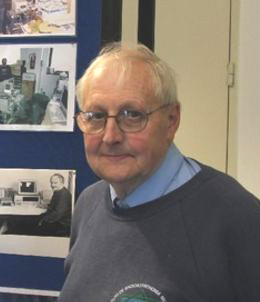 Glyn Haslam at Effelsberg 40th anniversary celebrations (Photo courtesy of Richard Wielebinski)
Glyn Haslam at Effelsberg 40th anniversary celebrations (Photo courtesy of Richard Wielebinski)
C.G.T. (Glyn) Haslam
Contributed by Richard Wielebinski
Glyn Haslam died on August 27, 2013 in England. He was born in Egerton, UK on August 4, 1936. He earned his PhD in Jodrell Bank in 1963 with his involvement in the early continuum observations with the Mark I (now Lovell) radio telescope. Glyn was involved in the mapping of the Andromeda Nebula and later started a 408 MHz survey of a section of the northern sky. This survey used early computing methods for plotting the sky maps.
Glyn Haslam joined the Max-Planck-Institute for Radio Astronomy in Bonn in 1970 in the very early phase of its expansion. In 1970 the 100-m radio telescope was under construction and the three directors were recruiting staff to be ready for observations once the 100-m radio telescope became operational. Glyn joined the radio continuum group of Richard Wielebinski and implemented the NOD2 data reduction package for mapping observations. Glyn witnessed the early drive tests in Effelsberg and became involved in the study of oscillations that occurred in this phase of construction. He was living at the telescope site and came up with the idea of putting a 408 MHz receiver in the telescope. Welding still took place that was a source of interference. However, after initial technical problems were overcome, the gathering of 408 MHz data started. In fact, when the official opening of the Effelsberg radio telescope took place on 12th May 1971 it was the 408 MHz survey observations that were demonstrated to the many important visitors.
The oscillation problem was solved and full astronomical observations were started in the middle of 1972. There was a continuum receiver for 2.75 GHz and later a system for 10.6 GHz. Haslam began to use both systems showing that his NOD2 software was capable of handling the high frequency Effelsberg data. At first, observations of supernova remnants and radio galaxies were made. This led quickly to the development of polarisation reduction software within the NOD2 system. The mapping of the Andromeda Nebula in polarisation was a crowning combination of the excellent drive software and the NOD2 data reduction system. However the completion of the all-sky 408 MHz survey was in the back of Glyn's mind. In view of the interest of Australian colleagues in observing at Effelsberg it was opportune to negotiate an exchange agreement with the CSIRO Radiophysics Division. The result was an agreement that one person at a time from MPIfR could work in Epping with access to the Parkes telescope. Glyn Haslam was the first person 'to be sent to New South Wales' to complete the southern extension of the 408 MHz survey. Numerous helpers joined Glyn for the many observing sessions. On his return to Bonn, Glyn got a group of close collaborators together for the completion of the remarkable data set, in a way the logo of the MPIfR - the 408 MHz all sky survey. The 408 MHz survey is still, after nearly 40 years, a basic template for studying the synchrotron emission of the Galaxy. It has been cited over 800 times and continues to be used also by satellite (WMAP, PLANCK) continuum projects for the subtraction of the foreground Galactic emission.
The MPIfR NOD2 software has evolved over the years. It was exported to many countries (Australia, Argentina, China, Japan, Canada, France/IRAM, USA/NRAO-Arecibo). For single radio telescope data the NOD2 system proved to be excellent. A description of the system was given by Haslam in 1974 with complete documentation. However additional routines that were constantly developed led to some problems of documentation. The dedication of computer-oriented users led to the evolution of the NOD2 system.
Glyn Haslam was a technically oriented radio astronomer of the old generation. He was not only interested in astronomical data but had also a very close insight in the technical problems. His method of working was to construct everything himself. In particular in his early days in Jodrell Bank Glyn was an inspiration to the more observationally oriented colleagues. In his later years Glyn became involved in the implementation of multi-pixel bolometers for the Pico Veleta mm-telescope. Important results at 1.2 mm wavelength were obtained using the NOD2 software adapted to such multi-beam observations.
Many will remember Glyn as the tea maker with need of extended discussions. Outside the institute he was an ardent hobby model aeroplane flyer. His car was often filled with model aeroplanes in various stages of completion. His interest in model railways led occasionally to raised eyebrows when complex rail layouts appeared on the MPIfR printers. Glyn's inventive spirit led him to develop a bar code system for controlling his model railway - well ahead of the commercial use of such technology. He also continued right up to the last days to come up with exhibits of historical radio astronomy projects. After retirement in England, Glyn began to develop amateur radio telescope systems for use in schools. He attended the celebrations to mark the 40th anniversary of the 100-m radio telescope inauguration in Effelsberg in May 2011 - his great lifetime interest. Glyn Haslam contributed greatly to the reputation of the MPIfR. He will be missed by those that knew him.
![[IAU logo]](iau_wb_thumb.jpg)
![[URSI logo]](URSI-logo-thumb.jpg)
![[Karl Jansky at his antenna]](jansky_photo_02_thumb.jpg)
![[Reber's Wheaton antenna]](Reber_Telescope_Wheaton_thumb.jpg)
![[Dover Heights]](Dover_Heights_02_thumb.jpg)
![[4C telescope]](GB61-195_4C_telescope_thumb.jpg)
![[Ewen and horn antenna]](ewen_horn1s.jpg)
![[Dwingeloo, 1956]](Dwingeloo-1956-thumb.jpg)
![[Jocelyn Bell Burnell and Cambridge antenna used in pulsar discovery]](burnell2_thumb.jpg)
![[Lovell Telescope at Jodrell Bank]](site_1594_0001-500-334-20180316163019-thumb150.jpg)
![[Wilson, Penzias, and Bell Labs horn antenna]](wilson-penzias-horn_thumb.jpg)
![[6-m Millimeter Radio Telescope in Mitaka, Japan]](6m-thumb.jpg)

